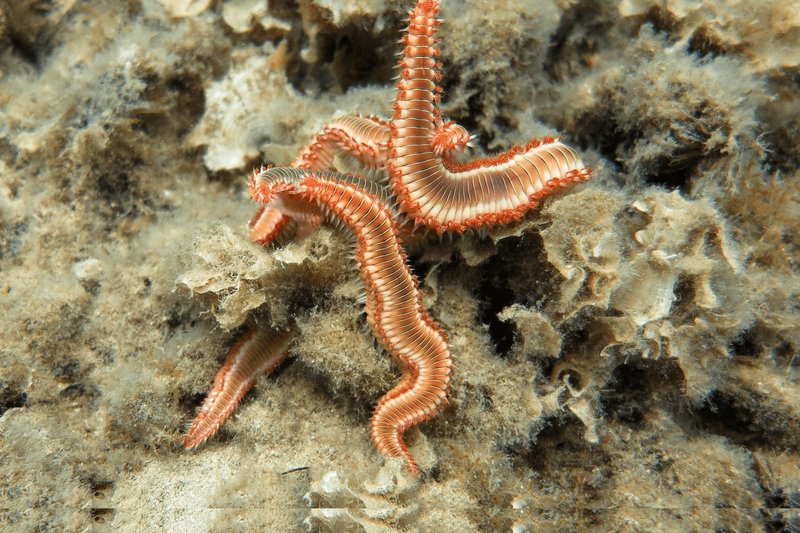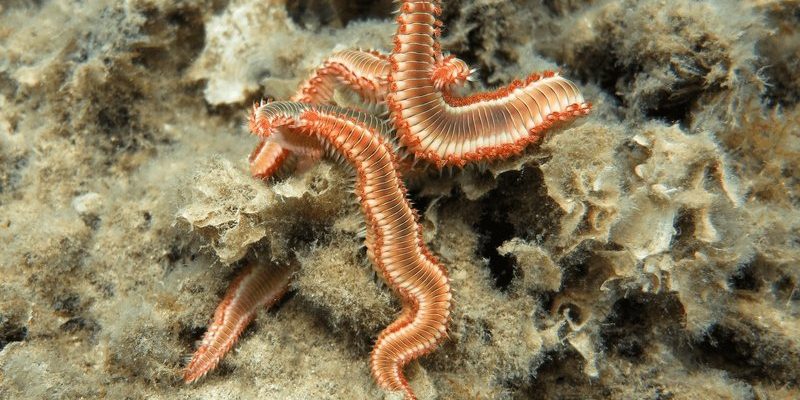
Bristle worms are fascinating marine creatures that play important roles in their ecosystems, and the red tufts you see on them can be a clue to their health, behavior, or living conditions. Let’s dive deeper into what these red tufts signify and why they matter for both the marine environment and your aquarium.
What Are Bristle Worms?
Bristle worms belong to a group of segmented worms called polychaetes. They’re usually found in marine environments, and their bodies are made up of numerous segments that help them move through sand and mud like an underwater inchworm. You might have seen them in your aquarium or during a dive, often hiding in the substrate or among rocks.
These creatures are usually harmless and can even be beneficial to your reef tank. They help break down organic matter, cleaning up waste and providing valuable nutrients for other organisms. Think of them as nature’s little recyclers, always working behind the scenes to keep things in balance.
But here’s where it gets interesting: some bristle worms display striking colors, and red tufts are among the most eye-catching. You might be wondering if these colors signify something special, and that’s exactly what we’ll explore next.
Understanding the Red Tufts
Now, what do those red tufts actually mean? First off, it’s important to note that these tufts can vary in appearance. They might look like fuzzy little pom-poms or feathery antennas. In many cases, they’re gills, which means the worm is using them for breathing. Just like we use our lungs, bristle worms use their gills to take in oxygen from the water around them.
When you see red tufts, it can indicate that the worm is healthy and thriving. Healthy bristle worms are often colorful, reflecting a well-balanced environment. However, a sudden change in color can point to stress or changes in water quality, prompting you to check the tank’s parameters.
If you’re wondering why they might change color, think about how we might blush when we’re embarrassed or get pale when we’re sick. For bristle worms, their colors can change based on their conditions—whether they’re happy, stressed, or even trying to attract a mate!
Environmental Factors Behind Color Changes
Several environmental factors can affect the color of bristle worms, including water quality, temperature, and food availability. Maintaining a balanced ecosystem in your aquarium is crucial for the well-being of these creatures.
1. **Water Quality**: Poor water quality can lead to stress and unhealthy changes in bristle worms. This means you should regularly test for ammonia, nitrite, and nitrate levels. A spike in these can lead to color changes, and not in a good way.
2. **Temperature Fluctuations**: Sudden changes in temperature can upset the delicate balance of an aquarium. Bristle worms prefer stable conditions, so it’s essential to keep the temperature consistent for their health and vibrancy.
3. **Food Supply**: Just like any living creature, bristle worms need food to thrive. If they’re not finding enough to eat, their colors might dull or change. Ensuring a balanced diet, whether from natural detritus or added foods, will help keep them colorful and healthy.
Keeping an eye on these factors can mean the difference between vibrant, active bristle worms and a tank that’s struggling.
The Role of Red Tufts in the Ecosystem
Red tufts aren’t just pretty—they serve important roles in the ecosystem. When bristle worms are abundant, they help aerate the substrate, creating a better environment for other organisms. This is similar to how earthworms improve soil quality in gardens.
Additionally, bristle worms serve as a food source for various marine animals. Fish, crabs, and even some larger invertebrates will munch on them. In a balanced ecosystem, these interactions keep the food web healthy. If you see vibrant tufts, it can signal a robust bristle worm population, which is a positive sign for your reef tank.
On the flip side, if the population suffers due to poor conditions, it could impact the whole tank. A decrease in bristle worms may mean less aeration and an increase in waste buildup, which can lead to unhealthy water conditions.
How to Care for Bristle Worms
If you want to keep those red tufts looking bright and healthy, regular maintenance of your tank is key. Here are some steps to ensure your bristle worms thrive:
- Monitor Water Conditions: Regularly check your water parameters, ideally weekly. This includes testing for pH, ammonia, nitrites, and nitrates.
- Maintain Temperature: Invest in a reliable heater and thermometer to keep a stable temperature that suits your tank’s needs.
- Provide a Balanced Diet: Supplement your tank with detritus and other foods that bristle worms can consume. This is crucial for their health and color.
- Reduce Stress: Limit disturbances in the tank. Avoid over-fishing or introducing aggressive species that might threaten the worms.
By following these tips, you can help ensure that the bristle worms in your tank not only survive but thrive, bringing those vibrant tufts to life.
Common Myths About Bristle Worms
There are a few common misconceptions about bristle worms that can lead to unnecessary fear. One of the major myths is that they’re harmful and can wreak havoc in your tank. While it’s true that some species can be pests, most bristle worms are benign and beneficial.
Another myth is that all bristle worms with red tufts are dangerous. In reality, many are harmless scavengers that help with tank cleanliness. Getting to know the specific species in your aquarium can help alleviate fears and allow you to appreciate their role.
Lastly, many believe that if they see bristle worms, their tank is unhealthy. This is not the case! A few bristle worms can be a good sign of a balanced ecosystem, as they often indicate a well-managed tank.
Final Thoughts on Bristle Worms and Their Red Tufts
Red tufts on bristle worms can tell you a lot about the health of your aquarium and its ecosystem. Whether they’re thriving or struggling, these little creatures are an essential part of the marine environment. By keeping an eye on their color and understanding what it signifies, you can create a better habitat for all your tank’s inhabitants.
So next time you spot a bristle worm sporting those striking red tufts, take a moment to appreciate what’s happening beneath the surface. It’s a reminder of the complex and beautiful web of life thriving in your aquarium. With proper care and understanding, you can enjoy a vibrant underwater world that’s both healthy and captivating.

